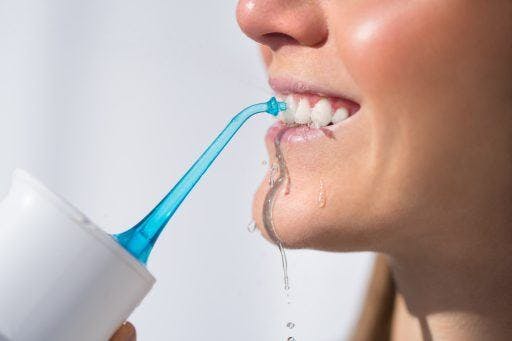You might have encountered an ad for water floss while scrolling through your social media feed. Immediately, questions start popping up in your head. Could you floss with water? How was it different from gargling? Have you been flossing wrong this whole time?
Australian Dental Association says there is indeed more than one way to floss your teeth, and water flossing is among the most popular. Here is everything you need to know if a water flosser suits you.
What Is Water Floss?
Dental floss uses nylon thread, which you insert between your teeth and move back and forth to remove food particles. Some people find this floss type challenging, especially for reaching tight spaces in the mouth. Water flossers for teeth may not give you this problem.
A water floss or oral irrigator uses pressurised water powerful enough to dislodge food debris between your teeth and along your gum line. As a result, it can provide a more thorough way to target hard-to-reach parts of your teeth.
How to Use a Water Flosser
Follow this step-by-step guide to maximise the benefits of your water flosser:
- Connect the flosser to a water source or fill it manually.
- Lean over the sink.
- Place the nozzle in your mouth.
- Choose your preferred pressure and switch it on.
- Go from tooth to tooth, following the gumline.
- Disconnect the flosser from the water source.
- Clean your device thoroughly.
What Are the Pros and Cons of Water Flossing?
Grains of leftover food can build up into plaque along your gum line. They can harden into tartar, leading to bleeding gums or infections like periodontitis. Water flossing can be a gentle and effective way to maintain good oral hygiene, especially if you have existing dental issues.
However, water flossing has its pros and cons, like any dental tool. Understanding the advantages and disadvantages can help you decide whether it’s right for you.
PRO: Water flossing can help you avoid bleeding gums.
Some studies have shown that water floss may reduce gum bleeding and inflammation more effectively than traditional flossing. Nylon flossing can unintentionally force you to become abrasive as you scrape food debris between your teeth. Flossing with water is a much gentler operation.
CON: A water flosser can be pricey.
Some water flossers come with adjustable pressure settings, interchangeable nozzles, and other features to customise the cleaning experience to your needs. You also spend for a water floss tip or head replacement every six months.
PRO: Water flossing deep-cleans your teeth without fuss.

Cleaning your teeth with nylon thread means flossing in a C-shape movement, which people either ignore or don’t know. You don’t need a specific technique in water floss for deep cleaning.
You lean over the sink and direct the flosser’s tip in your mouth along your gumline and between your teeth, pausing briefly at each area. However, you may have to hold the tip at a 90-degree angle to your teeth for thorough cleaning.
CON: Water flossing can be messy.
The pressurised stream of water can cause water to splash outside the mouth, especially if the pressure setting is too high. As a result, you can get water on your face, clothes, or the bathroom counter. Use the device over a sink to minimise water splashing. You should also stick to regular nylon floss when travelling or working.
Oral irrigators also require regular cleaning. Drain the water flosser’s tank and rinse the tip to remove moisture. You don’t want any mildew growth on your device. It is best to follow the manufacturer’s cleaning instructions carefully.
PRO: Water flossing is excellent for people with dexterity issues.
People with arthritis, carpal tunnel syndrome, or other conditions affecting dexterity may find it challenging to manoeuvre dental floss between teeth. They may also not have the strength to hold and manipulate a flossing device. Water flossing eliminates the need for manual dexterity. Instead, they come with ergonomic handles and easy-to-use buttons.
CON: Finding the right water flosser can be a trial-and-error process.
There are water flossers that require electricity, which limits their portability. There are also cordless ones – though sometimes, their water capacity may not be enough.
Using the pressure settings will require an adjustment. Start with a low level first and work up to the high-pressure feature. Water flossers also come with different heads or tips for specific use like orthodontic and gum care.
Water Flossing with Dental Appliances
Dentists may recommend water floss when you have braces or dental implants because water is gentler on dental devices. There is also less risk of damage to dental appliances, which can happen with improper use of regular floss.
The downside is that water floss cannot always flush out food bits that accumulate around brackets and wires. For instance, if you have braces, you must visit your dentist to clean your teeth meticulously. You can avoid experiencing this problem with aligners.
Unlike braces, aligners like those by ClearCorrect are removable, making it easy to clean your teeth with whatever floss type you have right now. ClearCorrect uses medical-grade plastic, making it easy to wash. By the way, these aligners are also transparent – making your orthodontic treatment subtle and comfortable.
Are Water Flossers Better Than Regular Floss?

Is it safe to use a water flosser every day? Your dentist understands the health of your teeth and gums best. Follow their advice about your daily dental care routine. They may recommend traditional flossing followed by oral irrigation to add another layer of protection against plaque and tartar build-up.
Limitations like bulkiness and cost can prevent you from using water flossers as often as nylon floss. As such, it’s best to build a habit and schedule on when to use the former instead.
So, is a water flosser as good as flossing? It’s always best to consult your dentist before getting a water flosser so they can assess your teeth and talk to you about the right water flosser, water pressure, and water flosser tip.
To Floss or Not to Floss? It Shouldn’t Be a Question
Studies reveal that although 80% of Australian adults brush their teeth more than two times a day, only 25% report cleaning in between their teeth daily. It means three out of four adults in the country must do more to protect their teeth from gum disease and decay.
If you’re part of the 25% taking those gaps between your teeth for granted, consider a water floss and pay more attention to where your toothbrush can’t go. Flossing once a day will make you feel great and help you make sure you have pearly whites to show off until you’re 80.
References:
Abdellatif, H., Alnaeimi, N., Alruwais, H., Aldajan, R., & Hebbal, M. (2021). Comparison between water flosser and regular floss in the efficacy of plaque removal in patients after single use. The Saudi Dental Journal, 33(5), 256–259.
Australia, O. (2023a, February 28). How to prevent bad breath with braces or clear aligners. Orthodontics Australia.
Australia, O. (2023, March 8). Periodontal Disease and Orthodontic Braces. Orthodontics Australia.
Cleaning between the teeth | Teeth.org.au | How To Floss Well. (n.d.). Teeth.org.au.
Luo, H., Wu, B., Kamer, A. R., Adhikari, S., Sloan, F. A., Plassman, B. L., Tan, C., Duesberg, G. S., & Schwartz, M. W. (2021). Oral Health, Diabetes, and Inflammation: Effects of Oral Hygiene Behaviour. International Dental Journal, 72(4), 484–490.
Mazhari, F., Boskabady, M., Moeintaghavi, A., & Habibi, A. (2018). The effect of toothbrushing and flossing sequence on interdental plaque reduction and fluoride retention: A randomized controlled clinical trial. Journal of Periodontology, 89(7), 824–832.
Tooth decay – Australian Dental Association. (n.d.). Teeth.org.au.



